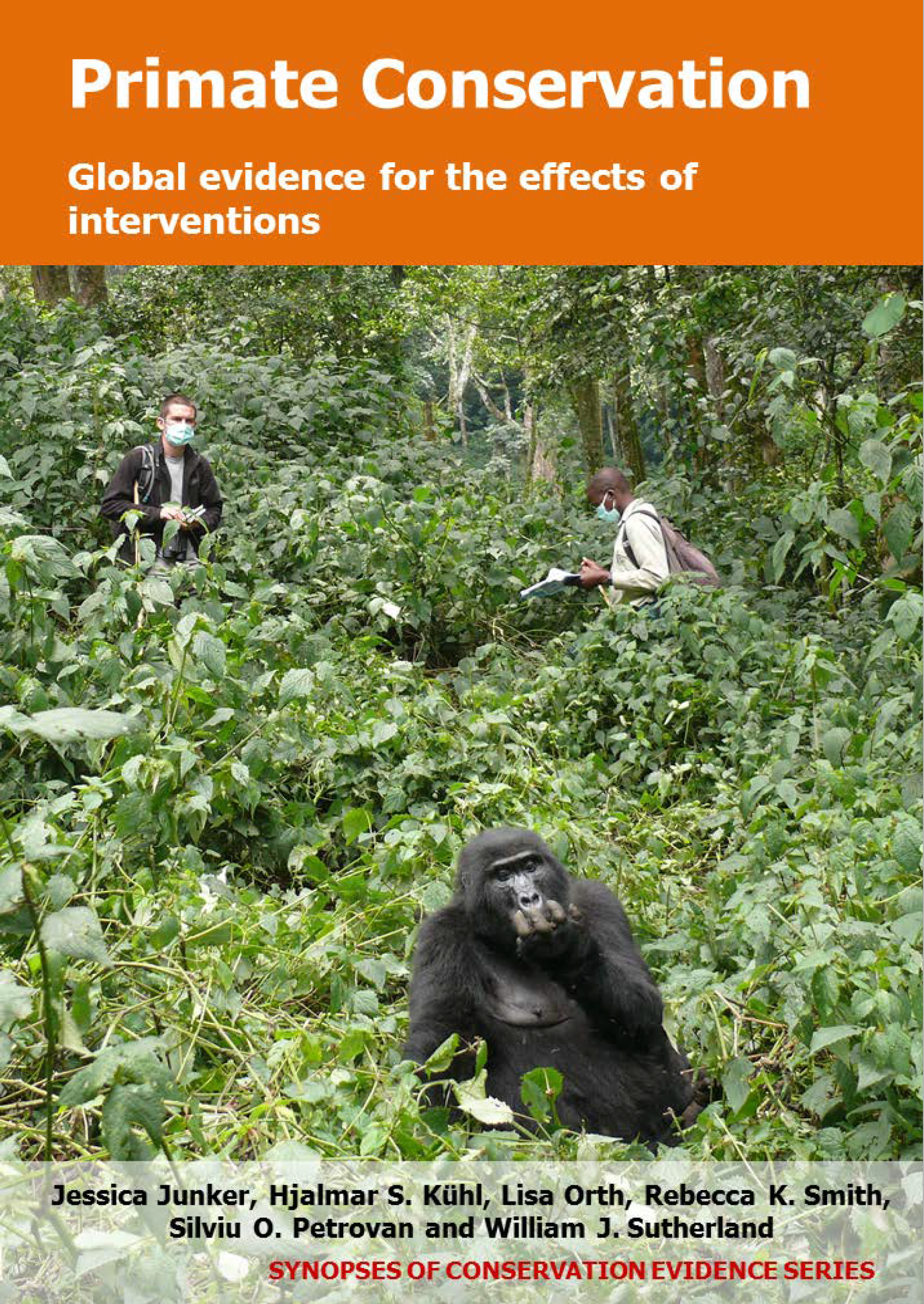Conduct regular anti-poaching patrols
-
Overall effectiveness category Likely to be beneficial
-
Number of studies: 5
View assessment score
Hide assessment score
How is the evidence assessed?
-
Effectiveness
70% -
Certainty
50% -
Harms
0%
Study locations
Supporting evidence from individual studies
A before-and-after trial in 1984-1987 in tropical montane forest in the Virunga ecosystem in Rwanda and the Democratic Republic of Congo found that mountain gorillas Gorilla beringei beringei that were protected by regular anti-poaching patrols along with other interventions, increased from 242 to 279 (15% increase) individuals in 1981-1986. Average group size increased from 8.5 to 9.2 individuals (17% increase) and proportion immatures increased from 39.7 to 48.1 individuals (8% increase) over the same period. Regular total counts of this population were conducted since 1973 by research staff. Anti-poaching guards regularly removed snares. Guards were provided with cars, radio communication equipment, uniforms, more rations and other equipment, which allowed them to increase patrol frequency and effectiveness. In 1979, a multi-organisation funded conservation project was initiated. A gorilla viewing tourism programme started in 1985, during which three gorilla groups were habituated for tourist viewing. The study does not distinguish between the effects of the different interventions mentioned above.
Study and other actions testedA review on the status of mountain gorillas Gorilla beringei beringei in 1972-1989 in tropical montane forest in Eastern Virungas Conservation Area, Uganda found that no gorillas were killed in 1989-1990 when the game guard force was increased from three to 13 men along with other interventions. Game guards were also provided with better equipment, and trained and supervised by researchers, who started working in the area in 1989 when a permanent research project was established. Human settlers were relocated from an area (3 km2) that represented the most important gorilla habitat within the Gorilla Game Reserve, within the Eastern Virungas Conservation Area. The study does not distinguish between the effects of the different interventions mentioned above.
Study and other actions testedA before-and-after trial and site comparison in 1976-1988 in tropical forest in Volcanoes National Park, Rwanda (3) found that the number of immature mountain gorillas Gorilla beringei beringei on the Rwandan side of the park increased and snares decreased after the implementation of regular anti-poaching patrols along with other interventions. Two years after the implementation of regular anti-poaching patrols, 30% of sampled quadrats on the Rwandan side of the park contained snares, compared to 70% of the sampled quadrats on the Ugandan and Congolese side. Numbers of immature individuals increased by 22% in Rwanda, but declined by 30% in the other two countries. No statistical tests were carried out to determine whether these differences were significant. Patrols were initiated in 1979, however, the study did not report on further details relating to the methods used to implement the anti-poaching patrols. Funds provided by the income of a tourist programme enabled the training, equipping and management of the anti-poaching patrols. In 1976, all cattle were removed from the park in Rwanda. A conservation education programme was also implemented, but no further details were reported. The study does not distinguish between the effects of the different interventions mentioned above.
Study and other actions testedA before-and-after study in 1967-2008 in tropical montane forest in Volcanoes-, Mgahinga-, and Virunga National Parks located in Rwanda, Uganda, and the Democratic Republic of Congo, respectively, found that despite regular anti-poaching patrols along with other interventions, the mountain gorilla Gorilla beringei beringei population decreased over time. Annual population decline was 0.7%, resulting in an overall population decrease of 28.7% over the entire study period. No statistical tests were carried out to determine whether this decrease was significant. Anti-poaching patrols were carried out throughout the entire study area. Rangers mostly used established trails, but made their own trails if signs of poaching were observed and followed these signs until they located the illegal activity. Patrol teams also regularly removed snares and herded live-stock out of the park. Additional interventions included local conservation education and community development projects. The study does not distinguish between the effects of the different interventions mentioned above.
Study and other actions testedA before-and-after trial in 2007-2009 in tropical forest in Kakum Conservation Area, Ghana (5) found that regular anti-poaching patrols along with other interventions, led to a decrease in illegal hunting activities for six primate species (bush baby Galagoides demidoff, Bossmann potto Perodicticus potto, Lowe’s monkey Cercopithecus campbelli lowei, spot-nose monkey Cercopithecus petaurista petaurista, olive colobus Procolobus verus and Geoffroy’s pied colobus Colobus vellerosus). In 2008-2009, the number of illegal hunting activities and hunting attempts decreased from 1182 to 874 (26% decrease). Monitoring consisted of foot patrols with randomized movements. Monitored illegal activities included the number of poachers arrested and escaped, gunshots heard, firearms confiscated, skins confiscated, poacher’s camps, animals killed, snares found, empty cartridges found and human footprints. Teams also regularly de-activated or removed ground snares. The study does not distinguish between the effects of the different interventions mentioned above.
Study and other actions tested
Where has this evidence come from?
List of journals searched by synopsis
All the journals searched for all synopses
This Action forms part of the Action Synopsis:
Primate Conservation
Primate Conservation - Published 2017
Primate Synopsis





)_2023.JPG)














